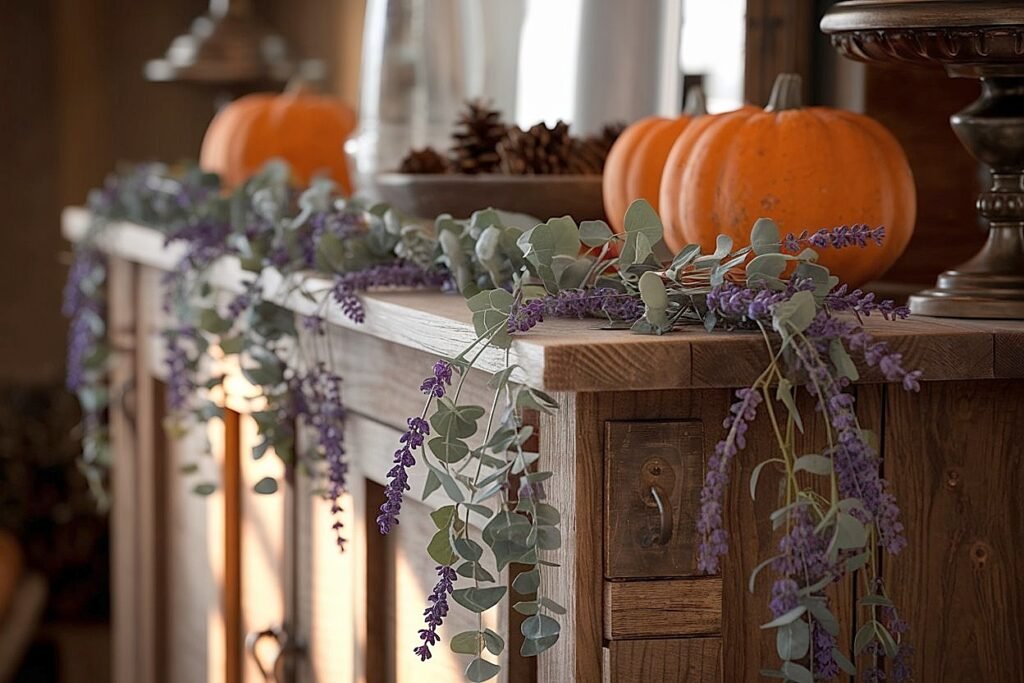
This website contains affiliate links, and some products are gifted by the brand to test. As an Amazon Associate, I earn from qualified purchases. Some of the content on this website was researched and created with the assistance of AI technology.
Key Takeaways
- Build slim, low-profile garlands: light first, structure second, lavender last—so scent floats without crowding plates or sightlines.
- Standardize palette and metals; repeat the same ribbon and greenery from table to sideboard and mantel for a single, calm visual story.
- Use short, wired lavender bundles spaced rhythmically (every 10–12 inches) and keep them away from heat sources and steam.
Using Lavender in Thanksgiving Garland Arrangements begins with restraint and rhythm. Lavender brings a cool, herbal hush to the warm rush of November—exactly the exhale a busy room needs. I design garlands that carry scent without stealing space, and I anchor them with disciplined mechanics so they survive a long meal, a bustling hallway, or a lively living room.
I learned to think in lanes and layers: lights first, greens second, lavender last. Keep profile under two inches on tables, four on mantels, and always wire short. The result is a quiet line that ties your dining table to the sideboard, windowsill, and fireplace without breaking conversation or blocking hands reaching for seconds.
Quick scan: Explore five essentials — Foundations, Placement, Accents, Lighting, and Continuity — that keep Thanksgiving lavender garlands cohesive from windows to sideboards.
| Core Topic | Focus | Windows & Furniture Cues | Quick Wins |
|---|---|---|---|
Foundations & Materials StructureTexture |
|
|
|
Zones & Placement RoomsFlow |
|
|
|
Accents & Add-Ons SeasonalDetail |
|
|
|
Light & Palette GlowColor |
|
|
|
Continuity & Guests CohesionExperience |
|
|
|
Foundations & Materials
- Bases: grapevine, jute, wire
- Lavender types: English, French
- Greens: eucalyptus, olive, cedar
- Measure spans across windows
- Anchor to mantels
- Secure hutches cleanly
- Alternate lavender clusters
- Blend dried + fresh
- Wrap ties with ribbon
Zones & Placement
- Mantels, stair rails, doorways
- Windowsills & sideboards
- Link open spaces
- Center below windows
- Bridge table & console
- Keep handrail safe
- Use removable hooks
- Let ends drape softly
- Echo lines between zones
Accents & Add-Ons
- Mini pumpkins & pinecones
- Burlap or velvet ribbons
- Glass décor to reflect light
- Show shimmer near windows
- Repeat accents on hutches
- Match ribbons to chairs
- Odd-number groupings
- Tie ribbons regularly
- Coordinate tray accents
Light & Palette
- Soft candlelight & micro LEDs
- Palette: lavender, cream, copper
- Two metals max
- Angle light toward windows
- Use mirrors for glow
- Lanterns on consoles
- Hide lights in greenery
- Keep flames low
- Capture at golden hour
Continuity & Guests
- Repeat lavender in each zone
- Craft mini favors
- Balance scent levels
- Seat guests comfortably
- Keep doorways open
- Benches for baskets
- Label décor zones
- Match napkin ribbons
- Gift lavender sprigs
How to Combine Lavender and Eucalyptus for Fragrant Thanksgiving Garlands
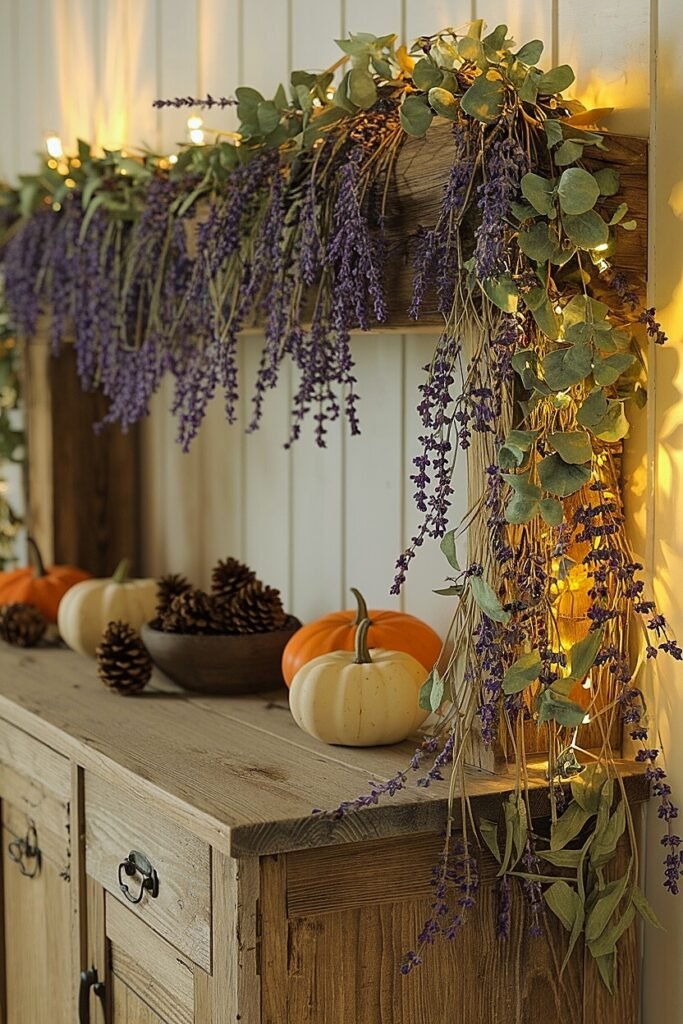
Lavender and eucalyptus speak the same cool language, but they need proportion. I start with a narrow spine of seeded or silver dollar eucalyptus, cut into 8–12 inch lengths. Using paddle wire, I overlap stems by a third, twisting in a consistent direction to keep the grain flowing. This creates a flexible base that drapes without kinking.
Lavender comes last. I wire 3–5 stem bundles at 4–5 inches and insert them at 45 degrees along the eucalyptus line every 10–12 inches. The angle suggests movement; the spacing prevents scent hotspots. If the garland sits on a table, I weave micro-LEDs into the eucalyptus before adding lavender so heat stays off buds and wires remain hidden.
Twist a slim eucalyptus backbone, add lights, then stitch short lavender bundles on 45-degree angles every foot for balanced fragrance and line. For complete table coordination, see How to Style Thanksgiving Dining Tables with Lavender Sprigs—and if this helps, share it with friends who love a calmer, fragrant holiday table. More plant choices ahead—keep reading.
What Are the Best Lavender Types for Thanksgiving Garlands?
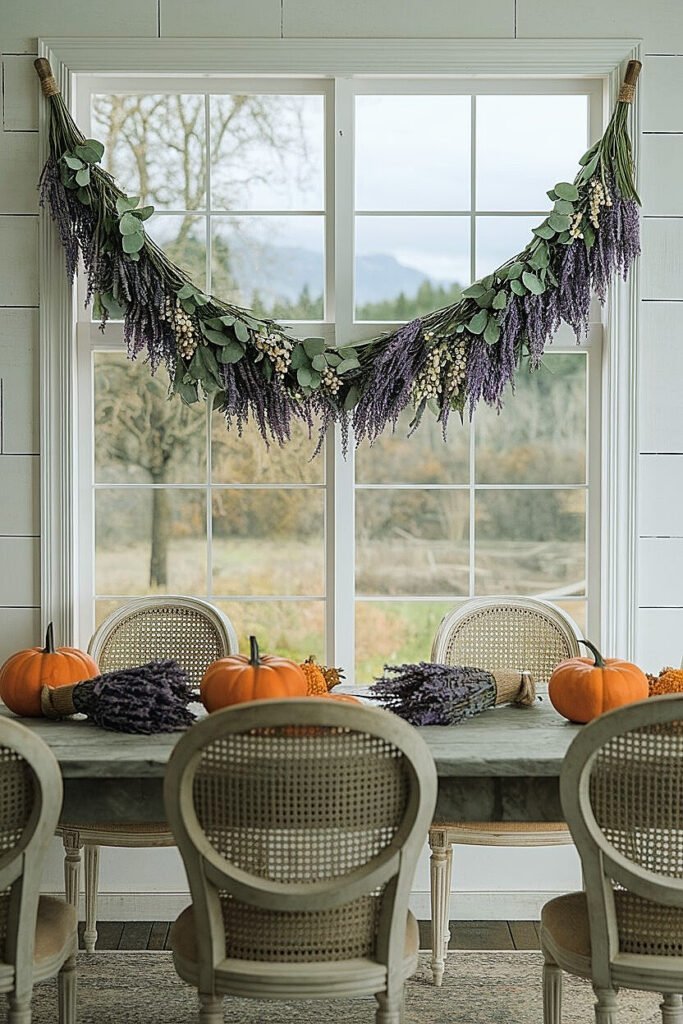
- English Lavender (Lavandula angustifolia): Its compact buds and refined scent make it ideal for close quarters like dining tables and windowsills. Short internodes wire cleanly, shedding is minimal when handled gently, and under candlelight it reads dusky and elegant rather than perfumey. I use English bundles as “commas” every foot to concentrate aroma without visual clutter.
- Lavandin (Lavandula x intermedia): Longer stems and generous bud density provide the line and reach you need for mantels and doorways. It dries reliably, holds shape over longer spans, and its slightly brighter, camphor-leaning note lifts large rooms. I use it as the structural lavender—continuous sweeps punctuated by English clusters.
- French/Spanish Lavender (Lavandula stoechas): The sculptural bracts add personality in very small doses. I treat Stoechas as accent notes at garland ends or near focal elements (mirror, sconce). Keep it away from steam and direct heat; it’s a shape-maker, not a workhorse, and it photographs beautifully.
English for close-in detail, Lavandin for span and line, Stoechas for sculptural punctuation. More texture next—keep reading to bind lavender into grapevine without bulk.
How to Weave Lavender into Rustic Grapevine Thanksgiving Garlands
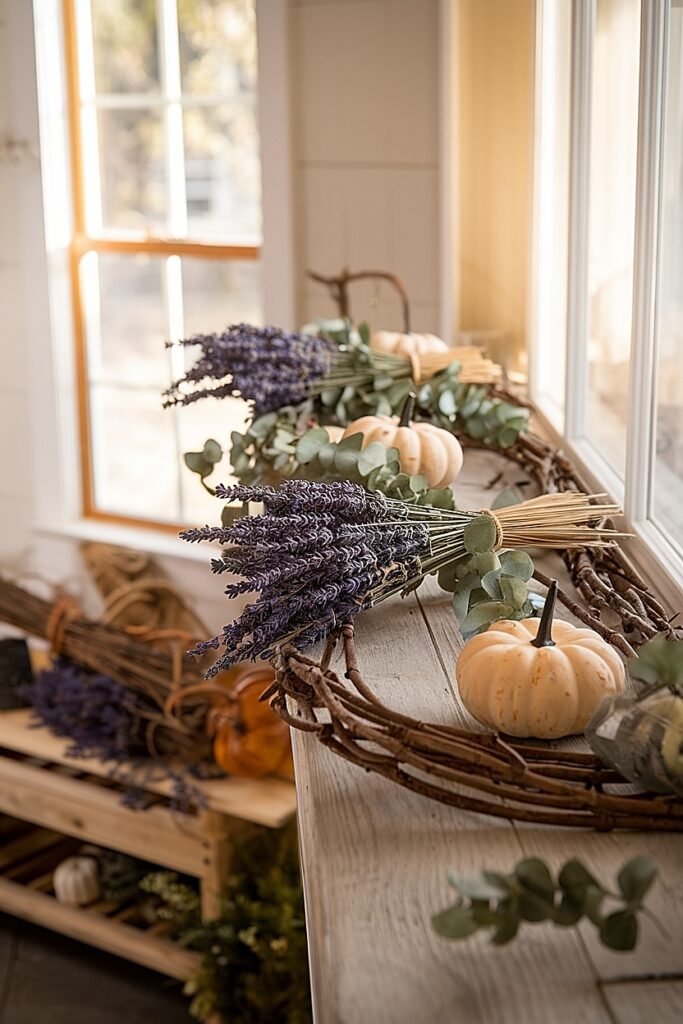
Grapevine provides instant backbone. I choose a slim, pliable coil and pre-shape it to the mantel or table curve. To avoid bulk, I thread lavandin stems into the vine’s natural gaps rather than stacking on top. Each insertion gets a discreet U-pin of wire that vanishes into the bark.
For detail, I add tight English bundles at visual beats—corners, centerline, or beneath sconces—then soften the transitions with a little olive or dusty miller. If the garland hangs vertically (stair rail), I point lavender tips upward; the line feels alive and prevents droop as stems dry.
Pre-shape grapevine, tuck lavandin into natural gaps with U-pins, and punctuate with English bundles at key sightlines; add silver-green leaves to soften. More autumn color next—keep reading to layer leaves with lavender without chaos.
Ways to Layer Lavender with Autumn Leaves in Thanksgiving Garlands
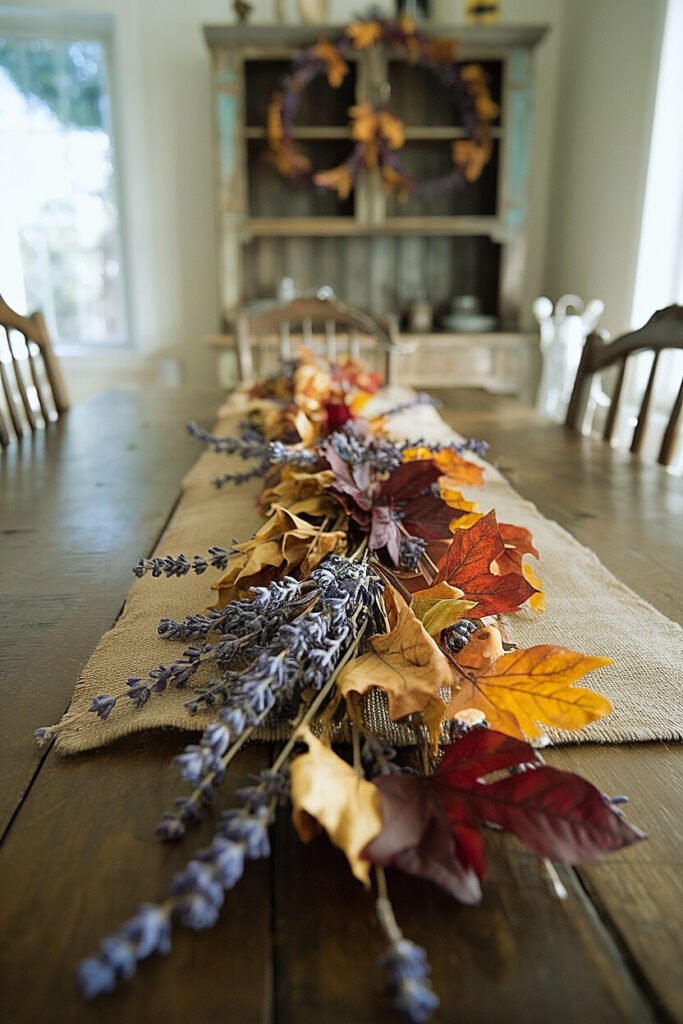
- Pressed Oak Leaves with English Tufts: I press oak leaves weeks in advance to keep them flat and obedient. I lay them like shingles along the eucalyptus spine, then attach small English lavender tufts at intervals. The cool lavender anchors the warm amber tones and keeps the line from feeling busy. Museum wax dots prevent drafts from flipping the leaves.
- Maple Gradients with Lavandin Sweep: I sort maple leaves by tone—butter to rust—and create a gentle gradient across the garland. A lavandin sweep rides just above the leaf line, connecting the color blocks. The contrast reads modern and editorial while staying seasonal, especially under warm LEDs.
- Bronze Beech with Dusty Miller Bridges: Beech leaves bring a satin bronze that pairs elegantly with lavender’s dusty bloom. I span transitions with dusty miller pads that hide mechanics and cool the palette. The result is soft, wintry, and incredibly photogenic at dusk.
- Eucalyptus Coins + Scattered Aspen: For a minimalist room, I mix eucalyptus coin leaves with a few pale aspen hearts, then thread lavender sparingly. The circular geometry calms the composition; lavender becomes punctuation rather than paragraph.
- Oak–Maple Mix with Ribbon Tails: When the palette goes eclectic, I corral it with short velvet ribbon tails tied at the ends and midpoints. Lavender bundles align with ribbon knots, turning potential clutter into a disciplined rhythm that guides the eye.
Curate leaf types and tones, fix movement with wax or wire, and let lavender act as the cool, consistent throughline. More small-scale charm next—keep reading for windowsill ideas that stay practical.
What Are some Unique Lavender Thanksgiving Garland Ideas for Windowsills?
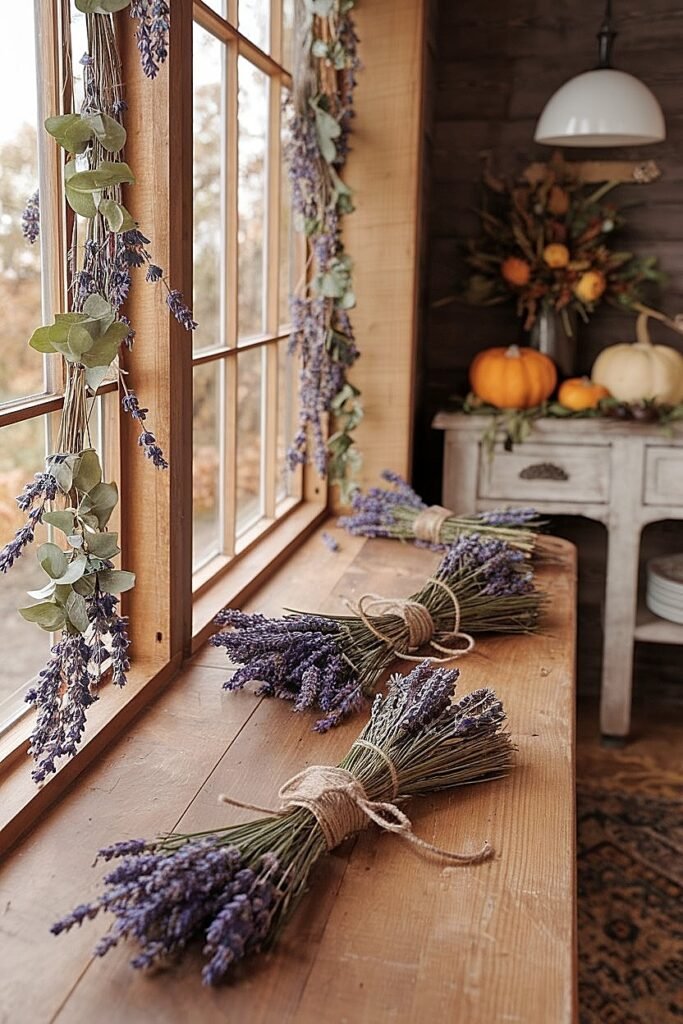
- Slim Olive–Lavandin Rail: A two-inch-high olive spine with lavandin stitched every foot. It frames the window without blocking light, and micro-LEDs on timers flip dusk into magic automatically.
- Jar-Link Garland: Short English sprigs in small glass jars connected by a thin linen cord. The jars act as scent stations and water sources if you’re using fresh cuts, while the cord sets a tidy cadence.
- Cloche Trio with Lavender Arcs: Three mini cloches over white minis or figs, linked by low lavender arcs. It’s protective in traffic-heavy rooms and reads curated in photos.
- Pewter Cup Run: A row of tiny pewter cups holds single English stems and the occasional juniper cluster. Low, weighty, and immune to drafts—perfect for old sash windows.
- Ribbon Bookends: A very slim lavandin garland capped with matching velvet ribbon “bookends.” This neat finish echoes napkin ties and keeps the look deliberate rather than thrown together.
Keep windowsill profiles lean, use timers, and repeat materials from the dining table for cohesion. More architecture next—keep reading to scale garlands for farmhouse mantels.
How to Style Lavender Thanksgiving Garlands on Farmhouse Mantels
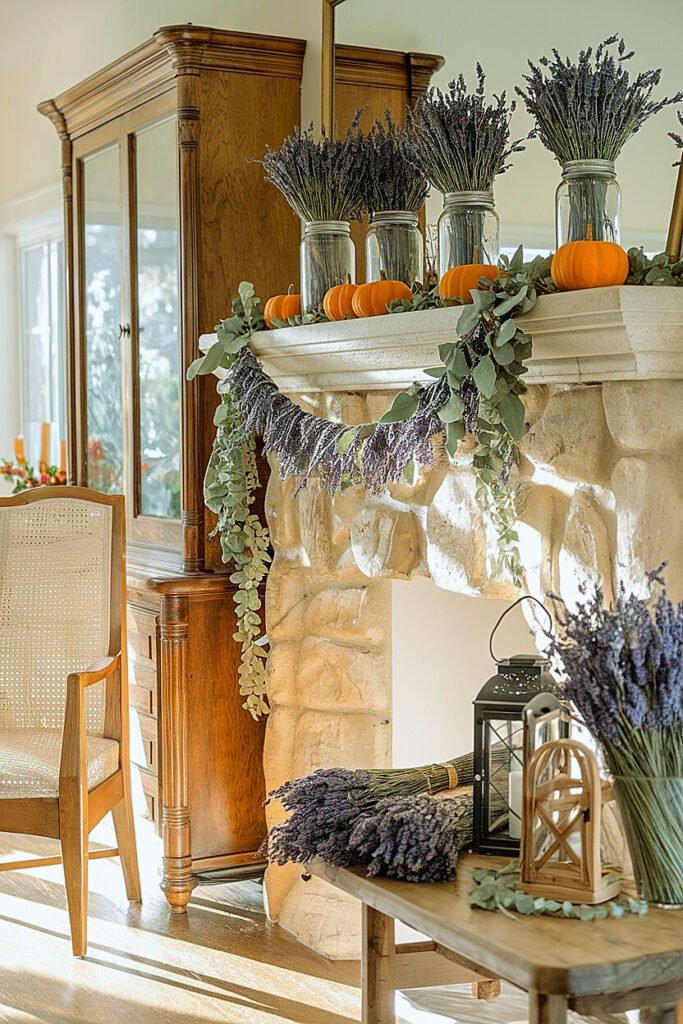
Mantels allow height but still demand discipline. I build a 3–4 inch profile: lavandin for span, olive for body, English clusters for scent. If a mirror hangs above, I align the garland centerline with the mirror’s center and avoid tall spikes that bisect reflections.
Lighting does the heavy lifting. I run micro-LEDs along the back edge to bounce off the wall, then place mercury cups in front to wash lavender with soft glow. If a fire burns, I push all botanicals at least eight inches above the opening and favor preserved stems for heat tolerance.
Keep mantel profiles under four inches, center the composition to architecture, and layer backlight plus votives to bathe lavender in glow without heat. More botanical partners ahead—keep reading for greenery pairings that never clash.
What Are the Best Greenery Pairings for Lavender Thanksgiving Garlands?
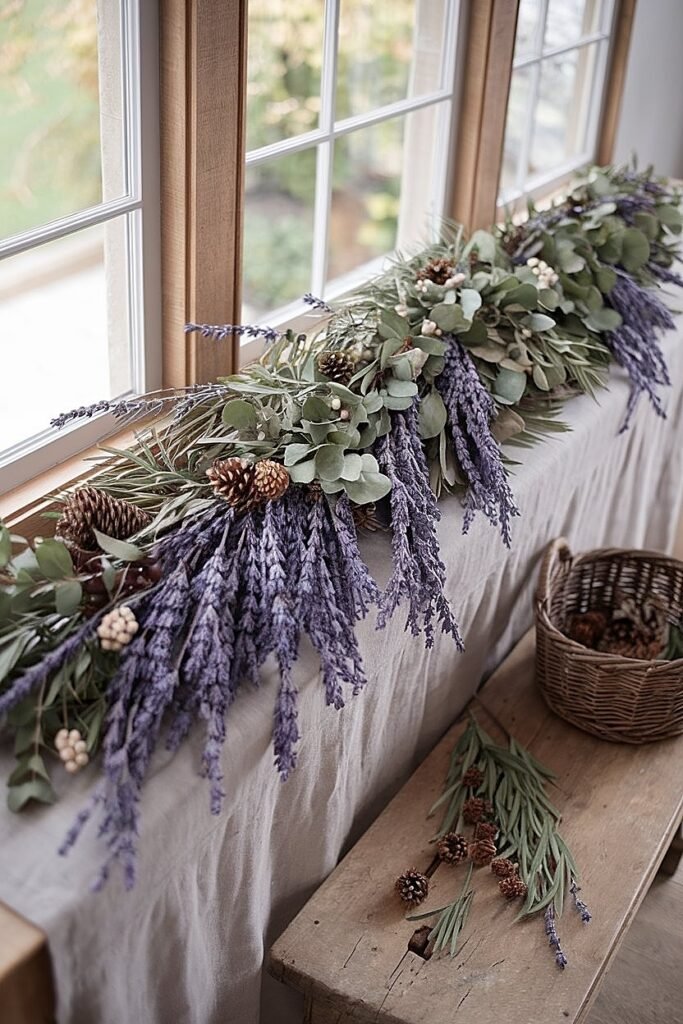
- Olive: Silvery undersides mirror lavender’s bloom and add Mediterranean ease. Flexible, forgiving, and elegant on tables and mantels alike.
- Seeded Eucalyptus: Movement and dotted texture that feels festive without glitter. Seeds catch light and hide mechanics beautifully.
- Dusty Miller: Plush, cool pads that soften edges and cool warm palettes. Best in small pads to avoid wilting near heat.
- Boxwood: Tight, architectural structure when you need a cleaner, traditional line. Use sparingly so it doesn’t overpower lavender’s delicacy.
- Juniper: Blue berries echo lavender’s tone and add winter whisper. A small percentage goes a long way; great for transitions and ends.
Choose one backbone green and one detail green; let lavender remain the throughline. More harvest synergy next—keep reading to weave pumpkins into the design.
How to Combine Lavender with Thanksgiving Pumpkins in Garland Design
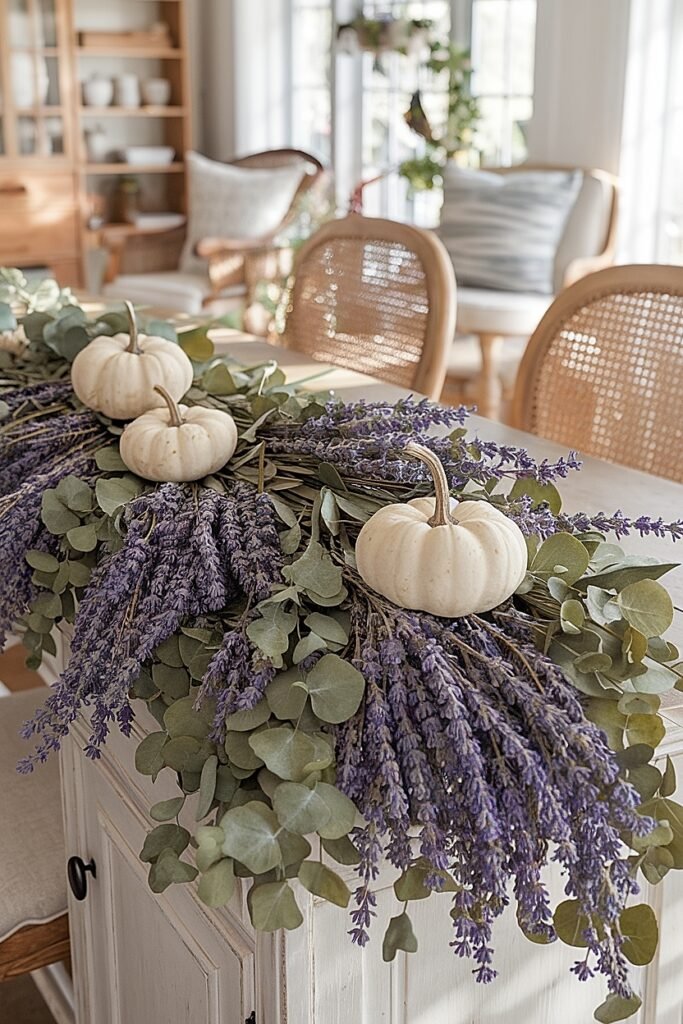
Pumpkins bring weight and seasonality; lavender brings movement and scent. I park small to medium heirloom pumpkins (white, pale green, café-au-lait) at garland beats—center and ends for mantels; every 18–24 inches on tables. I collar each pumpkin with a micro-wreath of lavandin and a touch of olive so they feel stitched in, not plopped.
For safety and surface protection, I set pumpkins on pewter saucers or ceramic tiles hidden under greens. Where space is tight, I use mini “Baby Boo” pumpkins inside lavender collars; it reads abundant without bulk and keeps platter lanes open.
Seat pumpkins at rhythm points on protective saucers, ring them with slim lavender collars, and keep finishes matte for cohesion. More dining tactics next—keep reading to drape garlands across the table like a pro.
Ways to Drape Lavender Garlands Across Thanksgiving Dining Tables
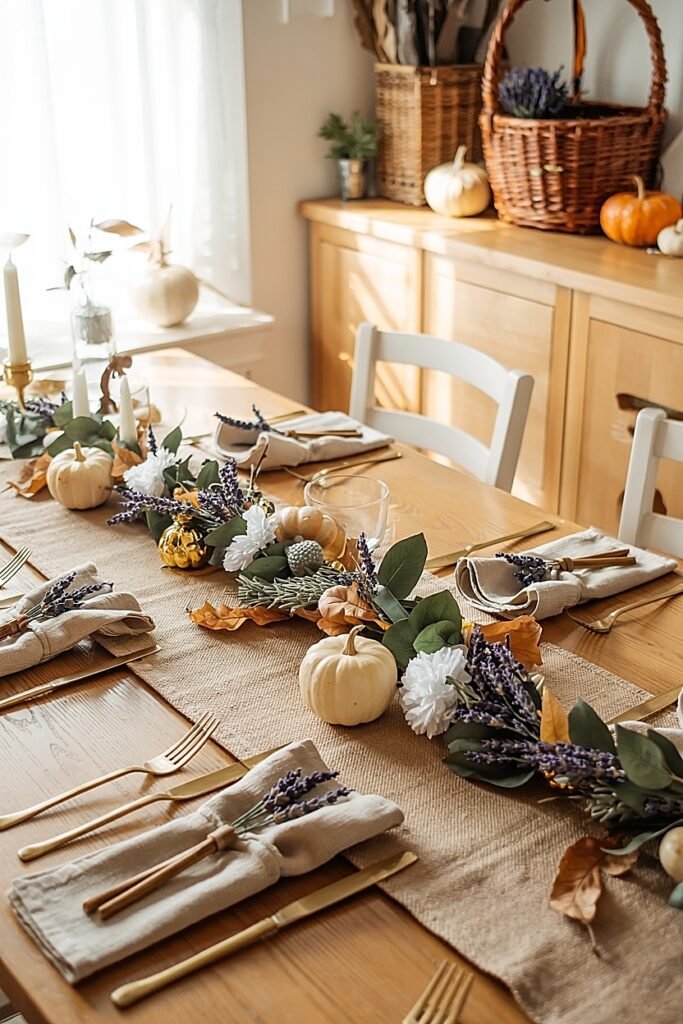
- Narrow Spine with Platter Bays: A 1–2 inch lavandin–olive spine threaded down a slim runner, with 12–14 inch open bays kept clear for serving. English bundles punctuate between bays for scent without obstruction.
- Corner-to-Center S-Curve: For square or round tables, an S-curve draws the eye and creates natural negative space. Micro-LEDs halo lavender along the curve, and minis or figs mark the bends.
- Double-Track Runner: Two parallel slim garlands flanking a central platter lane. This frames serving dishes and keeps conversation paths uncluttered; napkin ties repeat the ribbon color to stitch it together.
- End “Bookend” Clusters: If you prefer minimalism, concentrate lavender clusters at both ends of the runner with a faint connective line between. Guests feel the design without wrestling with décor near plates.
- Tray-Integrated Strands: Build short garland segments inside rustic trays. When it’s time to serve, lift and relocate the entire vignette to a sideboard without dismantling your look.
Keep profiles low, preserve serving lanes, and integrate light first; use tray segments for quick resets mid-meal. There’s more nuance across the piece—mix, edit, and let lavender set the room’s calm.
Conclusion
Lavender transforms Thanksgiving garlands when you honor mechanics and practice restraint. Twist a slim eucalyptus or olive spine, weave lights first, and stitch short lavender bundles last on a measured rhythm. Punctuate with heirloom pumpkins, fruit in contained pockets, and metals that echo across the room. Keep mantel profiles shallow, windowsills lean, and dining tables practical with platter bays. Repeat ribbon, standardize metals, and hide your wires. Do that, and your home will smell like calm, look composed, and feel unmistakably welcoming from the first pour to the final slice of pie.
This website contains affiliate links, and some products are gifted by the brand to test. As an Amazon Associate, I earn from qualified purchases. Some of the content on this website was researched and created with the assistance of AI technology.
